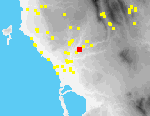 B07
Hora Palace of Nestor Lower Town
B07
Hora Palace of Nestor Lower Town
The so-called Palace of Nestor lies ca. 3 km SW of Hora. It is situated on the highest point of the Ano Englianos ridge[015.04][094.33][094.30], with excellent views SW to the coast[096.21] and NE inland. Because of its location, it is also visible from almost any high ground to the N, E, and S and can even be picked out from the site of ancient Koryphasion by Voidokoilia Bay.[015.23]
The results of excavation by Blegen of the central palatial structures, commencing in 1939, have been extensively published (PoN I-II). More recently, cleaning of the site as part of the preparation of a final site plan under the overall direction of Professor F. Cooper has produced further information regarding architectural phasing (annual reports in JHS-AR). In addition to excavation of the central palatial structures, Blegen also carried out tests in what he termed the 'Lower Town' (PoN III: 47-68), and excavated burial structures within the immediate vicinity of the palace: a large tholos tomb (Tholos IV; PoN III: 95-134) ca. 170 m. to the NE, an enigmatic structure termed by him the "Grave Circle" (probably another tholos tomb) 200 m. to the SW (PoN III: 134-76]), and a group of chamber tomb ca. 250-450 m. WSW (PoN III: 176-215).
PRAP has confined its investigation of the site to the surface remains outside the fenced area, including all those areas explored by Blegen. In particular, we carried out systematic tract-walking along the entirety of the Englianos ridge in 1992 to determine the probable maximum extent of the prehistoric settlement. Subsequently - in 1993 and 1994 - we collected artifacts on a 20-m. grid in those areas defined as most dense by tract-walking. This grid, comprising 474 squares, was divided into four quadrants, using the modern asphalt road as the division between N and S. Quadrant 1, therefore, lies NE of the palace; Q2 E and SE; Q3 (the smallest) SW; and Q4 (the largest) W and NW. Finally, on the basis of densities observed in the course of the grid collection, we carried out magnetometry[096.26] and resistivity[096.30] surveys in 1994 and 1995 primarily on the terraces W and SW of the palace structure - the area of Blegen's Lower Town and quite some distance beyond.
As a result of these investigations, we can say that the settlement surrounding the palace was much larger than previously estimated, perhaps 18 ha. (cf. UMME #1: 6.5 ha. minimum), bringing the total area of the site - including the palatial structures - to ca. 21 ha. We can also demonstrate the existence of material within that area extending from the EH/MH transition (notably in Q4) to LHIIIB as well as some PG and a small quantity of later material. The area of Q4 also yielded three fragmentary figurines (two human, one animal), numerous fragments of painted plaster, at least 7 loomweights and a spindle whorl.
Magnetometry and resistivity have produced encouraging results, suggesting the existence of a substantial linear feature some distance outside the modern fence to the W of the palace itself.
Two limestone blocks, spolia from the palace, were observed at site B1 ca. 2.5 km distant to the NE[003.09] and have been transferred to the palace site.
The pottery from the town around the palace of Nestor is plentiful, and prehistoric material is heavily predominant. The earliest material dates to the transition from EH to MH, and the rest of the Bronze Age is well represented from MH through LH IIIB. There may be a small Dark Age presence, but thereafter only a few isolated sherds represent the Geometric through Early Modern periods.
The Late Mycenaean material has all the characteristics of local settlement pottery, as observed at Nichoria in Eastern Messenia as well as in the palace itself. Open shapes are more common than closed, fine than coarse, and unpainted than painted. Paint is fugitive in any case. Only two fabrics can be dated with some confidence to specific periods: a dark pink fabric is characteristic of LH IIIA, and in LH IIIB a soft, greenish-white-yellow fabric (2.5Y 8/1-8/2, 5Y 8/1-8/2) is common enough at the palace of Nestor to merit the epithet "palace ware."